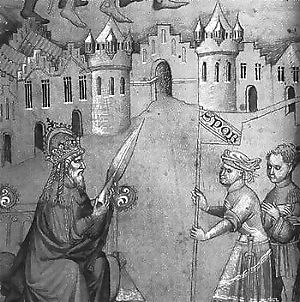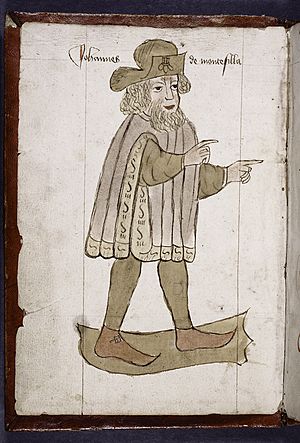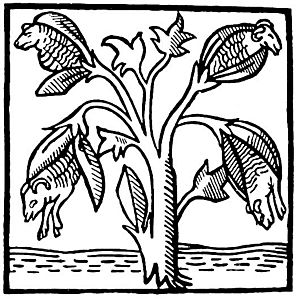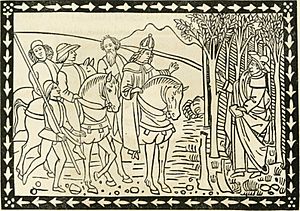Mandeville's Travels facts for kids
The Travels of Sir John Mandeville is a famous book written between 1357 and 1371. It pretends to be the travel diary of an English knight named Sir John Mandeville. The book describes his journeys across the Islamic world, all the way to India and China.
The first version of the book was in French, and it quickly became super popular. Even though many of the stories in it were not true and often quite fantastical, people used it as a real guide. For example, Christopher Columbus, the famous explorer, was greatly inspired by this book and by Marco Polo's earlier travel stories.
The book claims that John de Mandeville started his travels in 1322. He supposedly went through many places like Turkey, Persia, Syria, Egypt, Ethiopia, India, and China. He also said he visited Jerusalem many times. The author wrote the book in French because it was a language many people understood, more so than Latin.
It's pretty clear now that "Sir John Mandeville" was not a real person. He was an invented author. Many experts believe the real writer was someone from France or the Low Countries (like Belgium or the Netherlands) who probably didn't travel as much as the book describes. The book mostly used information from other travel books, adding exciting and sometimes unbelievable stories. However, some parts, especially about the Holy Land, Egypt, and the Levant, might contain real facts and knowledge from people who actually lived or traveled there.
Contents
Where Did the Stories Come From?

Experts have studied the book carefully to find out where its stories came from. It turns out that "Mandeville" borrowed a lot from other writers.
Odoric of Pordenone
A large part of the distant travels, from Trabzon to India and China, was taken from the stories of Friar Odoric (who traveled around 1330). Mandeville often added extra details, usually very wild ones, to Odoric's accounts. Sometimes, Mandeville even misunderstood Odoric's descriptions. For example, Odoric accurately described how Chinese people used trained cormorants to catch fish. But Mandeville changed them into "little beasts called loyres," which seems to be a mistake for "otters."
People noticed early on that Mandeville's stories were very similar to Odoric's.
Hetoum
Many of Mandeville's details about Asian geography and history came from a book called La Flor des Estoires d'Orient by Hetoum. Hetoum was an Armenian prince who became a monk. In 1307, he wrote down his amazing knowledge of Asia and its history.
Marco Polo
It's hard to find any parts of Mandeville's book that came directly from Marco Polo, except for one small detail. Mandeville mentions that in Ormus, people lie in water because of the extreme heat. Marco Polo also mentioned this. It's possible this detail was added to the copy of Odoric's book that Mandeville used.
Giovanni da Pian del Carpine and Vincent de Beauvais
Many facts about the Tatars (a group of people from Central Asia) were taken from the work of Giovanni da Pian del Carpine. He was a Franciscan friar who visited the Tatars as an ambassador from the Pope between 1245 and 1247. However, it's thought that Mandeville's direct source was actually another book called Speculum historiale by Vincent de Beauvais.
Amazing Creatures and Legends
The description of Prester John, a legendary Christian ruler in the East, came from a famous letter about him that was popular in the 13th century.
Many incredible stories about monsters are also included. These include creatures like Cyclopes (one-eyed giants), sciapodes (people with one giant foot), hippopodes (people with horse feet), and headless men (men whose heads grew beneath their shoulders). The book also talks about the phoenix (a mythical bird that rises from ashes) and weeping crocodiles. These stories likely came from ancient writers like Pliny the Elder and Gaius Julius Solinus, or from medieval books about animals.
The book also includes many stories and legends that pilgrims would hear on their journeys, especially in the Levant. These include tales like the legend of Seth and the paradise grains that grew into the wood of the cross, or the story of the dragon of Cos.
Who Wrote the Book?
In the introduction, the writer calls himself a knight and says he was born and raised in St Albans, England. But, as we know, "Sir John Mandeville" was probably not a real person.
Some experts believe the book was most likely written by a man named Jan de Langhe, also known as Jean le Long. He was a monk from Ypres (in modern-day Belgium) who lived in the 1300s. He loved collecting travel stories and wrote many books himself.
Evidence for the Real Author
There's no proof that a knight named Jehan de Mandeville ever existed in England at that time.
However, there's strong evidence that the book was put together by a doctor from Liège (a city in modern-day Belgium) named Johains à le Barbe, or Jehan de Bourgogne. A historian from Liège, Louis Abry, wrote that on his deathbed, "Jean de Bourgogne, dit a la Barbe" confessed to being "messire Jean de Mandeville, chevalier." He said he had to travel after accidentally killing someone in his home country. He arrived in Liège in 1343 and was known as a great scientist, philosopher, and astrologer.
This idea is supported by a tombstone in a church in Liège (now destroyed). It said that Mandeville, also known as "ad Barbam," was a medicine professor and died in Liège on November 17, 1372.
Even before he died, the Liège doctor seemed to admit his part in spreading and adding to the book. In one Latin version of the book, the author says that in 1355, after returning home, he came to Liège. He was sick with old age and gout and saw doctors. One of them, older and with white hair, was called Magister Iohannes ad Barbam. They realized they had met before in Cairo. This doctor then strongly encouraged Mandeville to write his travels. The book says it was first published in French by Mandeville in 1355 in Liège, and then translated into Latin there.
Did He Really Travel?
Even in the parts of the book that seem like real experiences, it's clear that another travel book was used. This was the journey of a German knight named Wilhelm von Boldensele, written in 1336. Mandeville often followed Boldensele's path but added many detours and often removed the German traveler's sensible observations.
For example, when talking about the pyramids, Boldensele wrote that people called them "Pharaoh's Granaries" but that this couldn't be true because there was no place to put wheat inside. Mandeville, however, completely changed this to support the old medieval belief: "Some say that they are tombs... but that is not true, for the common word... is that they are Joseph's Granaries... if they were tombs, they would not be empty inside."
There are only a few small parts of the book that might actually be the author's own experiences. But even these borrowed stories are often presented as if Mandeville himself experienced them. For instance, he claims he saw a garden of "transmigrated souls" in Hangchow, a story he took from Odoric. He also claimed that he and his companions stayed for 15 months with Kublai Khan, the Emperor of Cathay (China), during his wars. However, that war had ended about 70 years before Mandeville supposedly traveled.
One of the most famous false claims is when he takes Odoric's story of the Valley Perilous. Mandeville makes the story even more fantastical. He adds a detail about how some of his companions entered the valley with him, and only nine out of fourteen came out alive. This makes it sound like a real, dangerous adventure.
It's important to remember that not everything in the book is borrowed or made up. Even famous travelers like Ibn Battuta sometimes added invented experiences to their stories. Mandeville's book also contains some details that haven't been traced to other writers. These might be from the author's own experiences or from things he learned by talking to people in the East.
Whether Mandeville actually traveled or not, he might not have been trying to trick anyone on purpose. Many travel stories from that time used similar sources. This was a common way to make the narratives believable to readers.
About Egypt
It's hard to tell if his statements about Egyptian history are true. He describes the Bahri dynasty sultans of Egypt, borrowing from Hetoum. But he seems to speak from his own knowledge when he says that Sultan Al-Nasir Muhammad "reigned long and governed wisely." This was true, as Al-Nasir Muhammad ruled until 1341, and Egypt became very wealthy during his time.
However, Mandeville then says that Al-Nasir Muhammad's eldest son, Melechemader, became sultan but was secretly killed by his brother, Meleclimadabron. He claims this brother was the sultan when he left. In reality, Al-Nasir Muhammad was followed by eight of his sons in 13 years, and the names Mandeville uses don't quite match the actual rulers.
Words and Geography
Sometimes, Mandeville uses Arabic words, but they are not always easy to recognize, perhaps because of mistakes made by people copying the book.
Mandeville also shows a correct understanding of the shape of the Earth in some parts of the book. He knows about antipodes (people on the opposite side of the Earth) and that ships could sail around the world. He even tells a story he heard as a child about a man who traveled eastward until he returned to his own country. However, he also repeatedly states the old belief that Jerusalem was in the center of the world.
Copies and Translations
The oldest known copy of the original French manuscript is from 1371. The book was translated into many languages, including Latin and English.
The first English translation was made around the early 15th century. It had some errors because parts of the French manuscript it was translated from were missing. Later English versions also followed these flawed copies.
It's clear that the English versions were not written by Mandeville himself because they contain obvious translation mistakes. However, some English copies claimed in their introduction that Mandeville himself translated it from French into English.
An illuminated copy of the book from around 1440 was sold for a lot of money at an auction in London in 2011. The book was also translated into Early Modern Irish around 1475.
Other Works Using the Name
There are other books that use the name Mandeville or de Bourgogne.
For example, a short French life story of Saint Alban of Germany is attached to some copies of the Travels. The author of this story calls himself Johan Mandivill[e], a knight from St. Albans.
The doctor from Liège, Jehan de Bourgogne, also wrote a book about precious stones. He claimed he had been in Alexandria for seven years and received beautiful jewels from a Saracen friend.
De Bourgogne also wrote a book about the plague under his own name. In this book, he calls himself Johannes de Burgundia, also known as cum Barba, a citizen of Liège and a professor of medicine. He said he had practiced medicine for 40 years and was in Liège during the plague of 1365.
Dedications
- The orchestral music piece Hoc Vinces! by Svitlana Azarova is dedicated to Sir John Mandeville and people like him who inspired others to do great things, such as Christopher Columbus, Leonardo da Vinci, and William Shakespeare.
See also
 In Spanish: Juan de Mandeville para niños
In Spanish: Juan de Mandeville para niños
- Menocchio




